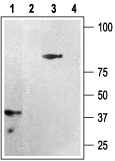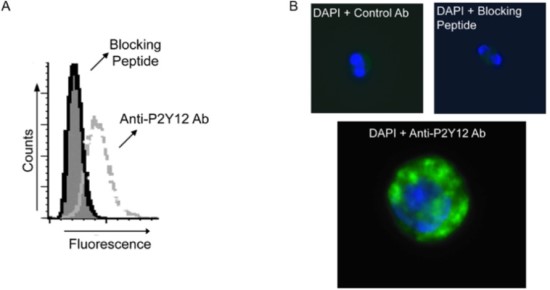Overview
- Peptide (C)KTTRPFKTSNPKNLLGAK, corresponding to amino acid residues 125-142 of human P2RY12 (Accession Q9H244). Intracellular, 2nd cytoplasmic loop.
- Rat brain membranes, human platelets (1:200).
 Western blot analysis of rat brain membranes (1 and 2) and human platelets (3 and 4):1,3. Anti-P2Y12 Receptor Antibody (#APR-012), (1:200).
Western blot analysis of rat brain membranes (1 and 2) and human platelets (3 and 4):1,3. Anti-P2Y12 Receptor Antibody (#APR-012), (1:200).
2,4. Anti-P2Y12 Receptor Antibody, preincubated with P2Y12 Receptor Blocking Peptide (#BLP-PR012). Western blot analysis of human platelets:1. Anti-P2Y12 Receptor Antibody (#APR-012), (1:200)
Western blot analysis of human platelets:1. Anti-P2Y12 Receptor Antibody (#APR-012), (1:200)
2. Anti-P2Y12 Receptor Antibody, preincubated with P2Y12 Receptor Blocking Peptide (#BLP-PR012).
- Mouse bone marrow lysate (Ribeiro-Filho, A.C. et al. (2016) BMC Pharmacol. Toxicol. 17, 29.).
- Mouse brain sections.
- Rat astrocytes (1:50) (Carrasquero, L.M. et al. (2005) Purinergic Signal. 1, 153.).
- Rat osteoclasts (8 μg/ml) (Alvarenga, E.C. et al. (2010) Bone 46, 355.).
- The blocking peptide is not suitable for this application.
The P2Y receptors belong to the G-protein coupled receptor superfamily. They mediate the actions of the extracellular nucleotides (ATP, ADP, UTP and UDPA). Eight functional mammalian P2Y receptors have been described: P2Y1, P2Y2, P2Y4, P2Y6, P2Y11, P2Y12, P2Y13, and the UDP-glucose receptor, now renamed P2Y14.1-3
The P2Y12 receptor is co-expressed with P2Y1 receptor on platelets leading to shape change, aggregation, and rise in intracellular Ca2+ upon activation.
The only other expression of P2Y12 was found in brain, according to results of reverse transcription-polymerase chain reaction and northern blotting.4 The P2Y12 receptor has become a target for potential therapeutic drugs for the treatment of thromboembolism and other clotting disorders.4
Application key:
Species reactivity key:

Expression of P2Y12 receptor in human eosinophils.A. Indirect flow cytometry of human eosinophils using Anti-P2Y12 Receptor Antibody (#APR-012). B. Immunocytochemical staining of human eosinophils using Anti-P2Y12 Receptor Antibody. P2Y12 immunostaining is shown in green. In both applications, preincubating the antibody with the blocking peptide abolishes the detection of the receptor.Adapted from Muniz, V.S. et al. (2015) PLoS ONE 10, e0139805. with permission of PLoS.
